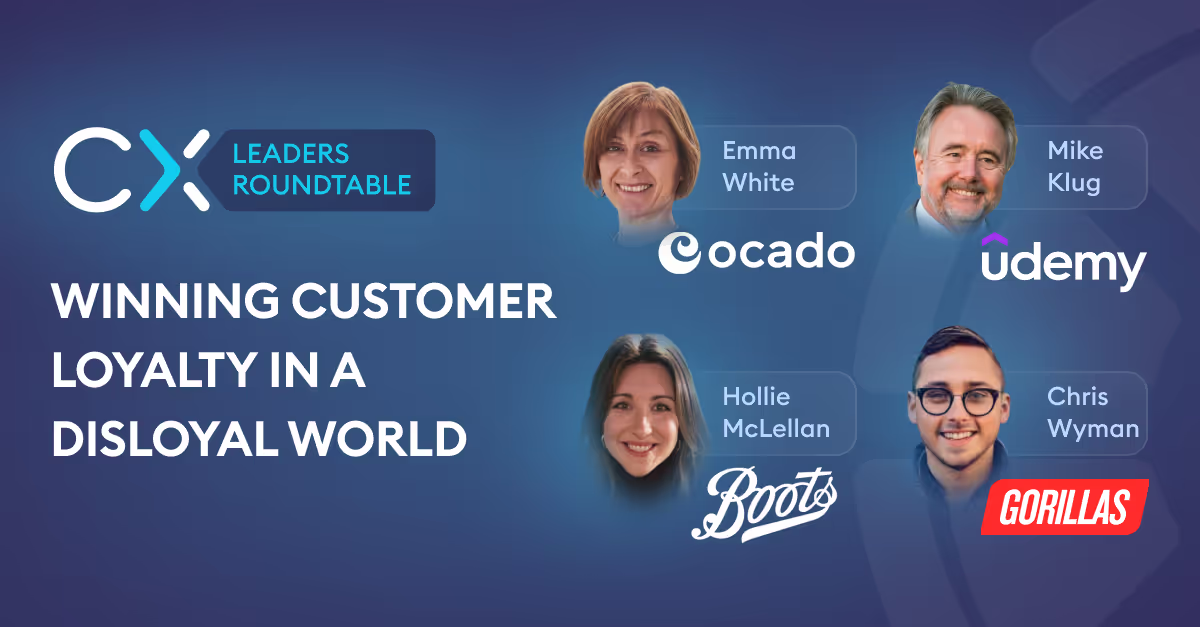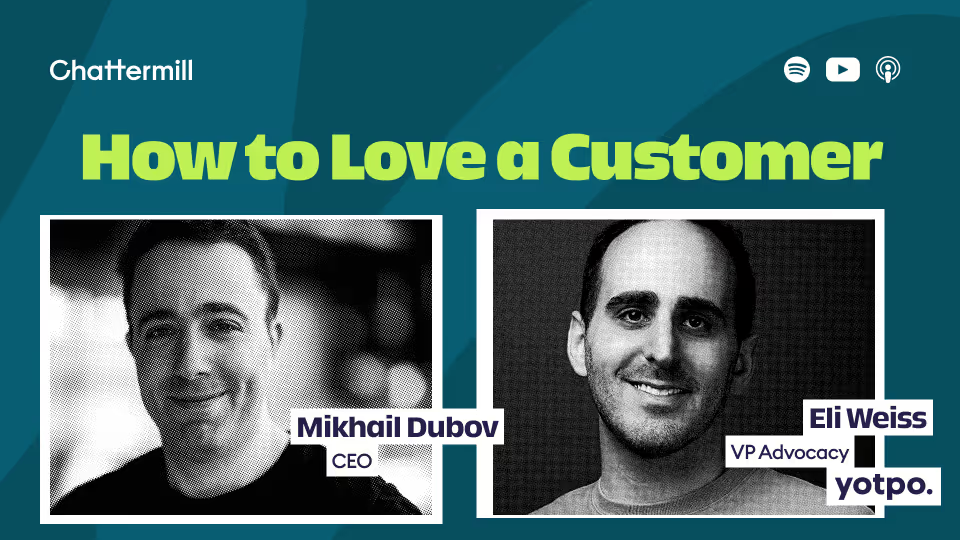Customer loyalty. That age-old challenge for CX leaders. How does one achieve it, and how do the best brands achieve their high customer retention levels? Especially when winning back consumers is so difficult as we all shop around more than before.
That’s what the latest CX Leaders Roundtable sought to find out. We got together some of the brightest minds from the world’s most customer-centric brands, including:
- Emma White – Research Manager at Ocado.
- Mike Klug – Senior Director of Customer Success at Udemy.
- Hollie McLellan – Customer Marketing and Loyalty Lead at Boots.
- Chris Wyman - Associate Director for Central Operations and CX at Gorillas.
Hosting it all, as usual, was Chattermill’s resident CX guru, Bradley Lawrence.
Read on for our key takeaways from the discussion. The full roundtable – including the Q & A – is available on-demand below. Make sure you give it a watch!
Right, let’s begin.

CX Leaders Roundtable: Winning Customer Loyalty in a Disloyal World - Chattermill
Customer loyalty: we’re living in a disloyal world
The springboard for the discussion is the top-level stat: 92% of global consumers don’t consider themselves brand loyal.

All of our guests agreed that they see this play out with their customers.
In the case of Boots, Hollie McLellan points to the near-universal trend that it is now much easier to compare prices elsewhere and to access new retailers. The Coronavirus pandemic has had a significant impact here – with more consumers now used to buying a more extensive range of products online and more used to seeing a broader range of deals.
According to McLellan, this drives Boots to focus more on offering a frictionless experience for digital transactions. Additionally, the company has seen Covid-19 have a significant impact on footfall to their bricks and mortar stores – particularly in city centres – which has pushed the brand towards being more predictive about where their customers are.
Ocado’s Emma White also points to the knock-on effects of Coronavirus and the UK’s current Cost of Living crisis.
‘At the start of the pandemic, we were part of a big change in the market where online grocery switched from just 7% of share to 12%,’ she says. ‘Since then, things have changed. People are going back to work. Children are going back to school. Life is opening up again now. Some people retained their habits, but some people didn’t. We want to keep our customers sticky. We’re looking at how we can encourage them to take advantage of our market-leading proposition, range, and service levels.’
Mike Klug offers a B2B take on recent loyalty trends. Udemy is a sales-as-a-service (SAAS) business with contracts typically lasting for one to two years – but much like the B2C brands, once these contracts are up, barriers to exit are shallow. Klug has also noticed another interesting trend: ‘I’ve seen customers getting more loyal if you’re providing value,’ he says.
Approach and strategies to winning customer loyalty
When it comes to improving loyalty, Gorillas’ Chris Wyman reflected on how his company are always looking at potential CX improvements across all areas of the brand.

‘Consumers have more choice than ever,’ he says. ‘What we focus on at Gorillas is not leaving anything off the table when it comes to optimisation – whether it’s selection, service, or pricing – and we’re constantly trying to find those ways we can raise the bar.’
For Emma White and Ocado, a big part of their approach looks at segmentation and personalising communications and offers based on that.
‘We wanted to really understand our customers so that we could talk to them in a way that resonated with them,’ she says. ‘We wanted segmentation lenses through which we could understand our customers both based on what they buy from us and the frequency with which they shop with us.’
‘We wanted to really understand our customers so that we could talk to them in a way that resonated with them,’ she says. ‘We wanted segmentation lenses through which we could understand our customers both based on what they buy from us and the frequency with which they shop with us.’
It’s a similar story for Boots. ‘Personalisation is the most important thing we’re doing right now,’ Hollie McLellan says. ‘But you can use personalisation in a clever way that doesn’t have to eat into the margin.’
Rather than embarking on a race-to-the-bottom of ever-cheaper deals, McLellan and her team use previous sales data to target, for example, customers who might be due to replenish their vitamins or to signal to those with loyalty points the products they could get by redeeming them.
Unlike Ocado and Gorillas, Boots is also still very reliant on the value of the in-store experience – with users coming in for one-on-one advice at the pharmacy or to try new beauty products in person. This is a big USP for the brand, giving customers more reason to re-engage even if they haven’t needed to visit a store in some time. This is similar to what we heard from Bravissimo’s Marketing & Digital Director, Julie Austin, late last year.
At Gorillas, Wyman points to a drive to only carry products that resonate with their customers. ‘We look at items on a per-item basis,’ he says, to eliminate any personal bias in what we are carrying.’
There is also a need to try and stick to the basics. This is manifested in a special effort to train the organisation’s couriers to be better and more friendly than their competitors.
For Mike Klug, at the B2B online course provider Udemy, they work at personalising things at the management level – striving to show their clients the learning trends related to the sector they are operating in.
A key aim for Udemy is to help their clients retain their employees. So having a comprehensive understanding of how their staff can upskill and develop their careers within their respective companies improves the chances that client managers will seek to renew contracts.
Analytics and attribution are crucial here, as it is for all at the roundtable. ‘Data is one of our most important strategic assets,’ Ocado’s Emma White says. ‘We’re trying to democratise it across the business.’
‘If ever a customer is lost, then each of our brands has the means to dig into all touchpoints on the customer journey to find out why – even if it isn’t mentioned specifically via a feedback form.’
Disloyal customers: how to win them back
Boots’ Hollie McLellan has quite a nuanced outlook, digging in a little further into winning back customers. ‘It’s hard,’ she says. ‘We have to think about how much money it’s worth. We have to think about what is going to bring them back.’

This can include telling lost customers about new products and new ranges and reminding them of the unique value Boots offers. McLellan also points to an acceptance that there will always be a section of the customer base making their purchase decisions based on price alone and will be less loyal to the brand in general.
McLellan and her team are also doing everything they can to try and ensure customers don’t leave in the first place – with models in place that accurately predict when a customer is likely to churn.
For Mike Klug and Udemy, losing customers is rarely down to something as simple as cost. It is usually more to do with losing sight of the executives and the sponsors at a company, a breakdown of communications, or the fact that they just aren’t servicing that user anymore.
To counter this, Udemy keeps track of the frequency of meetings with their clients and reviews these at the top of the company month by month.
Gorillas’ Chris Wyman describes the scientific approach they take to keeping track of the competition to try and ensure customers won’t be lured away by an alternative. They strive towards getting a balance of the core things they can’t ignore while also accepting that some of their competitors will be doing things they don’t need to worry about.
Wyman also speaks of multi-appers – those consumers who will likely have several delivery apps on their phone at any one time and will switch between them in the moment – rather than simply being loyal to any one particular brand.
Distinctiveness is critical for all at the roundtable. In the age of multi-appers, Gorillas still has a place in the delivery market partly because there is enough to set them apart. Indeed, Ocado is also on its own journey to reset perceptions and make itself stand out. They’ve changed the colours of their branding and are now trying to re-educate their customers on who they are and what they do.
With their particular trait of having a 100+ year history behind them, Boots also have a certain degree of distinctiveness to lean on. ‘It’s a pro, and it’s a con,’ McLellan says of the legacy. ‘The Boots brand is reliable and trusted, which lends itself well to health, but not so much to beauty.’
This means Boots tends to have two sets of marketing campaigns going on at any one time, with the beauty arm of the brand aligning much more with influencers, fashions and trends than the health side. It gives an added level of complexity to the already difficult task of keeping customers loyal. Still, it highlights just how much value the brand retains at a time when consumer habits are radically changing.
Watch the webinar again

CX Leaders Roundtable: Winning Customer Loyalty in a Disloyal World - Chattermill















